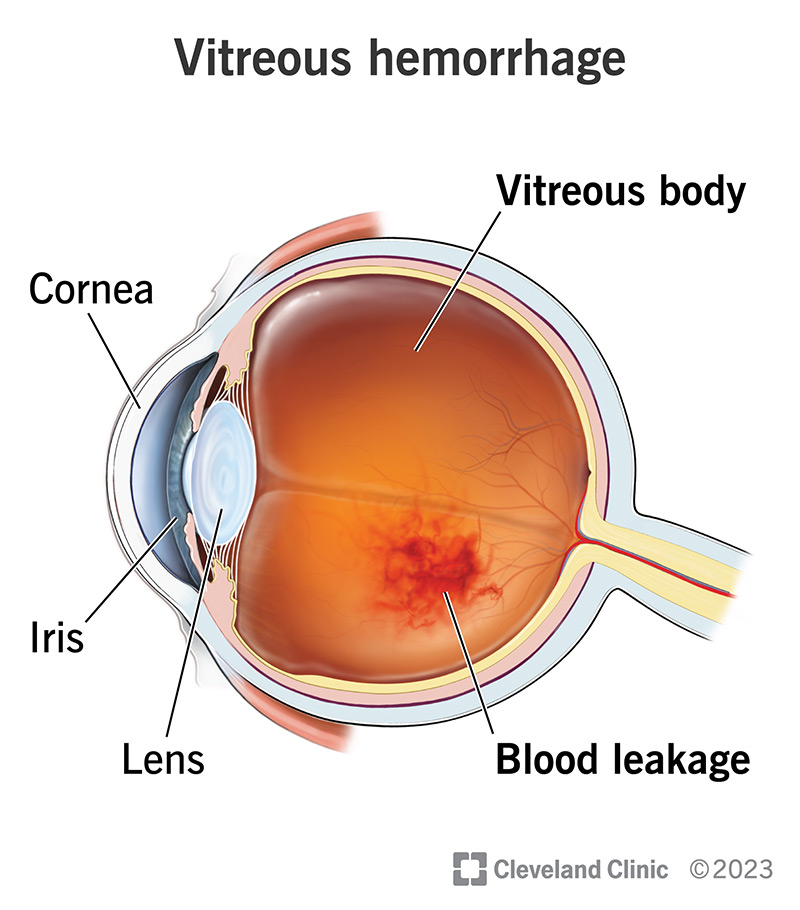Vitreous hemorrhage is when you have bleeding inside the vitreous, a space in your eye filled with a gel-like fluid. Having the symptoms means you need medical attention as soon as possible. It can happen for many reasons, most of which are treatable, but you need medical care to make sure it doesn’t get worse or isn’t something more serious.
Advertisement
Cleveland Clinic is a non-profit academic medical center. Advertising on our site helps support our mission. We do not endorse non-Cleveland Clinic products or services. Policy

A vitreous hemorrhage is when you have bleeding inside the vitreous of your eye, causing sudden — but painless — vision loss in that eye. It can lead to permanent vision loss, depending on what’s causing it.
Advertisement
Cleveland Clinic is a non-profit academic medical center. Advertising on our site helps support our mission. We do not endorse non-Cleveland Clinic products or services. Policy
It could happen for many reasons, so finding the underlying cause is a top priority before treating it. It’s more likely to happen in people with diabetes-related retinopathy.
The vitreous is the largest space inside your eye. It contains the vitreous body, a gel-like substance. The vitreous body is solid enough to help your eye hold its globe-like shape.
The main symptom of vitreous hemorrhage is sudden vision deterioration or vision loss. The vitreous is supposed to be clear so light can pass through it. Blood in the vitreous blocks that light, causing the symptoms.
Vitreous hemorrhage doesn’t cause changes that others can see in your eye. When this condition happens on its own, it doesn’t cause any visible bleeding at the front of your eye. Even with the right tools, eye specialists might have trouble seeing a hemorrhage that’s smaller or off to one side.
Vitreous hemorrhage happens when blood vessels in your eye leak blood into the vitreous. There are two main ways that can happen: mechanical force or an underlying disease.
There are several ways that physical force can cause vitreous hemorrhage. They include:
Advertisement
Diseases that weaken blood vessels in your eye or disrupt how they should work can lead to vitreous hemorrhage. Examples include, but aren’t limited to, the following:
Vitreous hemorrhage can also sometimes cause long-term vision changes. Some of these are permanent, while others just take longer to go away. Your eye care specialist can tell you more about what’s most likely to happen in your case and what you can or should do to help yourself recover.
An eye care specialist can diagnose a vitreous hemorrhage using a combination of methods. Usually, an ophthalmoscope or a slit lamp exam is all it takes to see the bleeding. Still, your provider may recommend additional tests to check for other possible bleeding causes.
Several lab and imaging tests can help diagnose vitreous hemorrhage or conditions that cause them. The most likely tests include:
There are a few different treatment approaches, and sometimes your treatment will involve more than one of these. They include:
Advertisement
Because there are so many treatment options, your eye care specialist is the best person to tell you more about the options most likely to help you.
If you have a vitreous hemorrhage, you can expect sudden vision loss or disruption, but it won’t hurt. The vision loss can look like a sudden appearance of floaters or a cobweb-like effect, or your vision might look hazy or cloudy.
How long a vitreous hemorrhage lasts depends on many factors. Those include what caused it, how severe it is and what treatments you received. It can take days or weeks for your vision to return to how it was before.
Blood in the vitreous can eventually settle to the bottom of your eye, but it takes time to do that. Your body can remove blood from the vitreous, but that's also a slow process.
The outlook for vitreous hemorrhage depends on what caused it and whether you got treatment quickly. Chronic conditions like Type 2 diabetes or macular degeneration tend to have worse outcomes. Your eye care specialist can tell you what's most likely for your specific case and what you can do to improve your own odds of a positive outcome.
Vitreous hemorrhage usually happens in ways you can’t predict or control, so they’re impossible to prevent. But there are a few ways to reduce your risk of developing them, including:
Advertisement
If you have sudden, painless vision loss, you need medical attention as soon as possible. You can’t self-diagnose or self-treat vitreous hemorrhage. You need a trained eye care specialist to diagnose it and offer treatment options.
Sudden, painless vision deterioration or vision loss can be troubling, and you shouldn’t ignore it. Quick diagnosis and treatment can make a big difference, and many treatment options are available. Talk to your eye care specialist if you have questions about vitreous hemorrhage or have a condition that may increase your risk of having one. They can help you better understand what you should watch for and how you can react to it.
Advertisement
Cleveland Clinic’s ophthalmologists and optometrists have the highest training available. We provide exams, vision correction and care for many eye conditions.

Last reviewed on 11/03/2024.
Learn more about the Health Library and our editorial process.